

This drawing is, I'm afraid to say, not clear as to what is shown and blowing it up larger doesn't help at all. I understand that there are no visable remains of the chapel on the site to-day (that is, assuming that anyone could find the site in the first place!) otherwise it might be worth a visit just to see if the drawing became clearer. My grandfather was, obviously, concerned at the state of the old ruin when he saw it in 1899 (see the newspaper cutting below).
The cutting is from the old "Bexhill Observer" and reads as follws: -

|
Northeye Chapel
To the Editor Dear Sir, - I was disappointed the other day when I found the ruin of Northeye Chapel in such an out-of-the-way and neglected spot. Cannot something be done to preserve this historical ruin? Yours Truly, John Jas Newport Hooe, June 21st., 1899 |

|
7th October 2025 - With the aid of modern AI search engines I have been able to add a little more detail to this; my first real attempt at doing so. The reason was that the idea of a search for a lost chapel intrigued me.
The first detail is through Wikipedia, and the original source is 'Driver, Leigh (1 June 2009). The Lost Villages of England. New Holland Publishers. p. 53.' [ISBN-13 978-1845374235 ?]
Northeye is the site of an abandoned medieval village known as Hooe Level on the Pevensey Levels, west of Bexhill-on-Sea. The village is mentioned as a dependent limb of the Cinque Port of Hastings in a charter of 1229. It is thought to have been deserted around 1400 AD. The village consisted of houses and a flint built chapel, The Chapel of St James.
According to the Historical England it is a Scheduled Monument, list entry 1002240, and first listed on 17th June 1975. National Grid Reference TQ 68226 07039.
The Google AI Search includes the statement 'Excavations in 1939 and 1952 uncovered the chapel's flint walls and medieval artifacts, and the site is now marked by disturbed ground', but the link to Historic England does not include this statement.